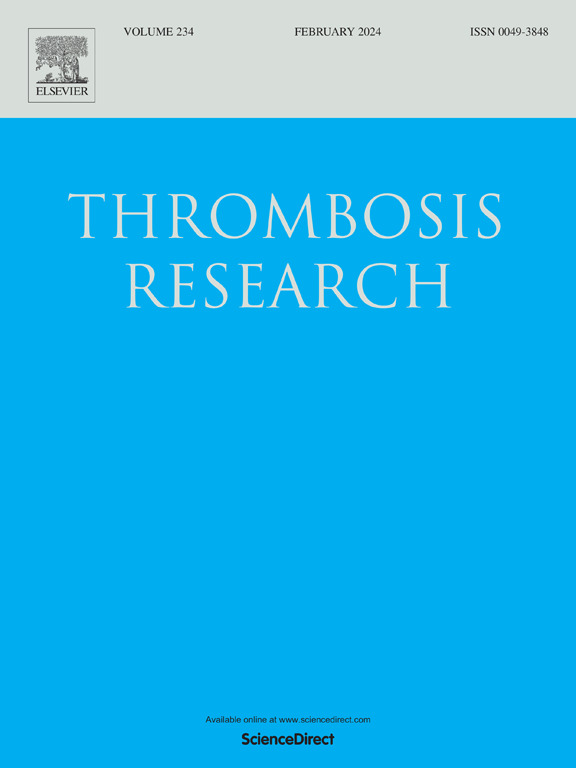Increased risk of pulmonary embolism in patients with dermatomyositis/polymyositis, a retrospective cohort study from Israel
IF 3.7
3区 医学
Q1 HEMATOLOGY
引用次数: 0
Abstract
Background
Despite the well-established association between chronic inflammatory conditions and pulmonary embolism(PE), previous investigations of the relationship between Dermatomyositis(DM) and Polymyositis(PM) with PE were scarce and have been subject to significant limitations, including small sample sizes and failure to account for potential confounders.
Objectives
To investigate the correlation between DM/PM and PE, as well as assessing the impact of serologic status, myonecrosis, and inflammation markers on this relationship.
Methods
In this large, nationwide population-based study, we used the Clalit Health Services medical database and extracted all DM/PM patients who were first diagnosed between 1 January 2002 to 31 December 2018 and compared them with age and gender matched controls in a ratio of 1:5. Serological and laboratory values were obtained for each patient. Rates of PE were compared between groups using multivariate models.
Results
The study included 1557 DM patients with 7633 controls, and 528 PM patients with 2560 controls. Compared with matched controls, the rates of PE were significantly higher in the DM/PM group, PM patients(2.8 % vs 0.5 % in controls, OR = 5.73, p < 0.001), DM patients(1.2 % vs 0.3 % in controls, OR = 3.42, p < 0.001). APLA seropositivity was significantly more prevalent in DM/PM patients compared with their matched controls, PM patients(10.8 % vs 2.7 % in controls, p < 0.001), DM patients(7.9 % vs 1.6 % in controls, p < 0.001). APLA seropositivity had a synergistic effect for PE in the DM/PM(OR = 23.18, p < 0.001).
Conclusions
DM and PM are associated with higher rates of PE. Furthermore, patients with DM/PM demonstrate a significantly higher prevalence APLA which act as a potentiator of thrombosis in these patients.
以色列一项回顾性队列研究:皮肌炎/多发性肌炎患者肺栓塞风险增加。
背景:尽管慢性炎症与肺栓塞(PE)之间的关联已得到证实,但以往关于皮肌炎(DM)和多发性肌炎(PM)与肺栓塞之间关系的研究很少,而且存在明显的局限性,包括样本量小和未能考虑潜在的混杂因素:调查DM/PM与PE之间的相关性,并评估血清学状态、肌坏死和炎症标志物对这种关系的影响:在这项基于全国人口的大型研究中,我们使用了Clalit健康服务医疗数据库,提取了2002年1月1日至2018年12月31日期间首次确诊的所有DM/PM患者,并以1:5的比例与年龄和性别匹配的对照组进行了比较。获得了每位患者的血清学和实验室数值。使用多变量模型比较了不同组间的 PE 发生率:研究包括 1557 名 DM 患者和 7633 名对照组,以及 528 名 PM 患者和 2560 名对照组。与匹配的对照组相比,DM/PM 组的 PE 发生率明显较高,PM 患者(2.8% 对对照组的 0.5%,OR = 5.73,P 结论:DM 和 PM 与较高的 PE 发生率有关:DM 和 PM 与较高的 PE 发生率有关。此外,DM/PM 患者的 APLA 患病率明显较高,而 APLA 是这些患者血栓形成的诱因。
本文章由计算机程序翻译,如有差异,请以英文原文为准。
求助全文
约1分钟内获得全文
求助全文
来源期刊

Thrombosis research
医学-外周血管病
CiteScore
14.60
自引率
4.00%
发文量
364
审稿时长
31 days
期刊介绍:
Thrombosis Research is an international journal dedicated to the swift dissemination of new information on thrombosis, hemostasis, and vascular biology, aimed at advancing both science and clinical care. The journal publishes peer-reviewed original research, reviews, editorials, opinions, and critiques, covering both basic and clinical studies. Priority is given to research that promises novel approaches in the diagnosis, therapy, prognosis, and prevention of thrombotic and hemorrhagic diseases.
 求助内容:
求助内容: 应助结果提醒方式:
应助结果提醒方式:


